Study on Extraction Method of Carotenoids from Citrus Leaves
ZHANG Wei, XIE Dan, WEN Zhi-yong, ZHONG Guang-yan
1. College of Science, Hunan Agricultural University, Changsha 410128, PRC;
2. Fruit Tree Research Institute, Guangdong Academy of Agricultural Sciences, Guangzhou 514640, PRC
Abstract In order to explore the extraction method of carotenoids from citrus leaves, the extraction effect of carotenoids from leaves of Honey pomelo by ultrasonic-assisted extraction was investigated by single factor experiment and orthogonal experiment. The results showed that the optimum extraction condition was: the ration of ethanol and acetone 1 ∶1(v/v, containing 0.1% BHT), solid-liquid ratio 1 ∶30 (g/mL), extraction time 7 min, ultrasonic power 240 W, extraction frequency 3 times. Under the above condition, the extraction rate of carotenoids was 85.98%.
Key words Citrus; Leaves; Carotenoids; Extraction methods
1. Introduction
Citrus carotenoids can prevent the production of superoxide radicals, avoid DNA damage, improve immunity, prevent cancer cells from growing and slow cardiovascular disease etc.[1]. At present, the reported extraction methods of carotenoids include organic solvent extraction, enzymatic extraction and supercritical fluid extraction etc. Each of these methods has its advantages and disadvantages. So far, there have been no reports on the extraction of carotenoids from citrus leaves, hence it is very important to explore the extraction technology. According to studies on the extraction of carotenoids[2-9], most of the substances exist in the form of esters. Therefore, mixed organic solvent was selected based on the theory of like dissolves like in the experiment. The extraction effects of carotenoids from citrus leaves was investigated by single factor experiment and orthogonal experiment to obtain the optimal condition with Honey pomelo as test material.
2. Materials and Methods
2.1. Test materials
The leaves of Honey pomelo were taken from the experiment site of Fruit Tree Research Institute of Guangdong Academy of Agricultural Sciences. The whole leaves of young or old leaves were selected as sample. All samples were quick-frozen in liquid nitrogen after being subpackaged and stored in a ultra-low temperature freezer at -80℃ for use. In the experiment, the cryopreserved samples were ground into a fi ne powder in a pulverizer precooled with liquid nitrogen.
2.2. Test methods
2.2.1. Calculation for extraction rate of total carotenoids from leaves
A certain amount of sample powder was weighed in a 50 mL centrifuge tube, a certain solid-liquid ratio extraction agent was added, and then placed in an ultrasonic cleaning machine for ultrasonic assisted extraction at certain power and time. The sample was centrifuged for 10 min at 4 000 r/min to obtain the supernatant. The extract was diluted to 10 mL brown volumetric fl ask at constant volume every time. Each treatment had three replicates and was taken average. The extract was detected by ultravioletvisible spectrophotometer at the maximum absorption wavelength of 445 nm. The whole test was conducted in dark light environment without UV to avoid the experimental error caused by the decomposition and oxidation of carotenoids.
The content was calculated according to formula (1), and taken as the total carotenoid content in the completely extracted sample. Of which, MTotalcarotenoidwas the content of total carotenoid (mg/g), 2500 was the empirical absorption coeffi cient of carotenoids.

Ultrasonic assisted extraction was used to extract the carotenoid of sample based on single factor experiment. A certain amount of the extracted solution was transferred and diluted to 10 mL, and then its absorbance was measured. The extraction rate was calculated according to formular (2). Of which, M was the content of carotenoid extracted by single factor experiment or orthogonal experiment; MTotalcarotenoidwas the content of carotenoid extracted by above method.
2.2.2. Single factor experiment
2.2.2.1. Effect of extractant ratio on the extraction rate of total carotenoid
0.500 0 g citrus leaves were accurately weighed and 40 kHz of ultrasonic frequency, 120 W of ultrasonic power, 1 ∶40 (g/mL) of solid-liquid ratio, 25℃ of extraction temperature, 5 min of extraction time and once extraction were set to investigate the effect of 7 extractant ratio (containing 1% BHT) on the extraction rate of total carotenoid. The solvent and ratio were shown in Table 1.
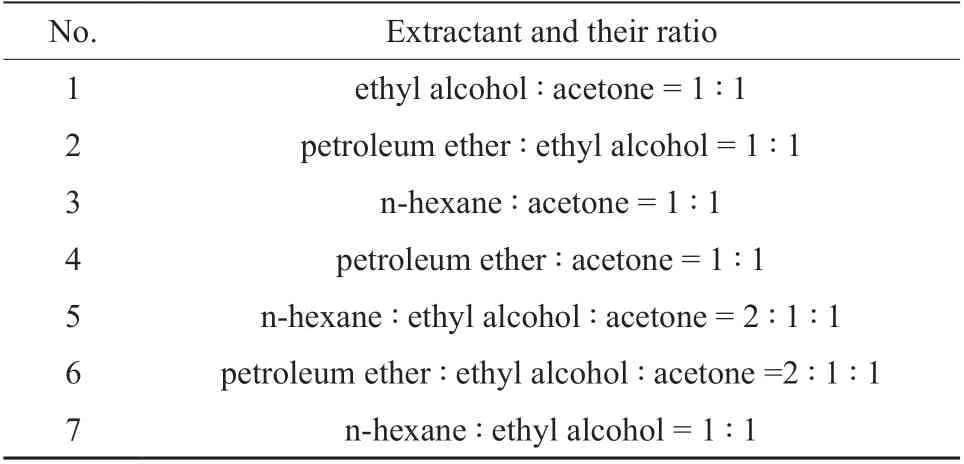
Table 1 Extractant and their ratio
2.2.2.2. Effect of solid-liquid ratio on the extraction rate of total carotenoid
0.500 0 g citrus leaves were accurately weighed. Ultrasonic frequency was 40 kHz, ultrasonic power was 120 W, extraction temperature was 25℃, extraction time was 7 min, extraction frequency was once, extractant ratio was ethyl alcohol ∶acetone = 1 ∶1. 1 ∶10、1 ∶20、1 ∶30、1 ∶40、 1 ∶50、1 ∶60 (g/mL)of solid-liquid ratio was set to investigate extraction effect.
2.2.2.3. Effect of ultrasonic power on the extraction rate of total carotenoid
0.500 0 g citrus leaves were accurately weighed. Ultrasonic frequency was 40 kHz, solid-liquid ratio was 1 ∶40 (g/mL), extraction temperature was 25 ℃, extraction time was 5 min, extraction frequency was once, extractant ratio was ethyl alcohol∶acetone = 1∶1. 150、180、210、240、270、300 W of ultrasonic power was set to investigate extraction effect.
2.2.2.4. Effect of extraction time on the extraction rate of total carotenoid
0.500 0 g citrus leaves were accurately weighed. Ultrasonic frequency was 40 kHz, ultrasonic power was 120 W, solid-liquid ratio was 1 ∶40 (g/mL), extraction temperature was 27℃, extraction frequency was once, extractant ratio was ethyl alcohol ∶acetone = 1 ∶1. 5、6、7、8、9、10 min of extraction time was set to investigate extraction effect.
2.2.2.5. Effect of extraction temperature on the extraction rate of total carotenoid
0.500 0 g citrus leaves were accurately weighed. Ultrasonic frequency was 40 kHz, ultrasonic power was 120 W, solid-liquid ratio was 1 ∶40 (g/mL), extraction time was 5 min, extraction frequency was once, extractant ratio was ethyl alcohol ∶acetone = 1 ∶1. 20、 25、30、35、40、45、50℃ of extraction temperature was set to investigate extraction effect.
2.2.2.6. Effect of extraction frequency on the extraction rate of total carotenoid
0.500 0 g citrus leaves were accurately weighed. Ultrasonic frequency was 40 kHz, ultrasonic power was 120 W, solid-liquid ratio was 1 ∶40 (g/mL), extraction temperature was 25 ℃, extraction time was 5 min, extractant ratio was ethyl alcohol ∶acetone = 1 ∶1. 1、2、3、4、5 times of extraction frequency was set to investigate extraction effect.
2.2.3. Orthogonal experiment
Based on above single factor experiment, orthogonal experiment including 4 factors and 3 levels was conducted to determine the optimal conditions for the extraction of total carotenoid by ultrasonic assisted extraction using solid-liquid ratio, extraction time, ultrasonic frequency, extraction frequency as factors and extraction rate as index. Factors and levels were shown in Table 2.
3. Results and Analysis
3.1. Effect of extractant on the extraction rate of total carotenoid
As shown in Fig.1, No. 1 (ethyl alcohol ∶acetone = 1 ∶1) had the best extraction effect, while No. 3(n-hexane ∶acetone = 1 ∶1) had the worst extraction effect. Comprehensive consideration, No. 1 (ethyl alcohol ∶acetone = 1 ∶1) was selected as extractant for follow-up test.
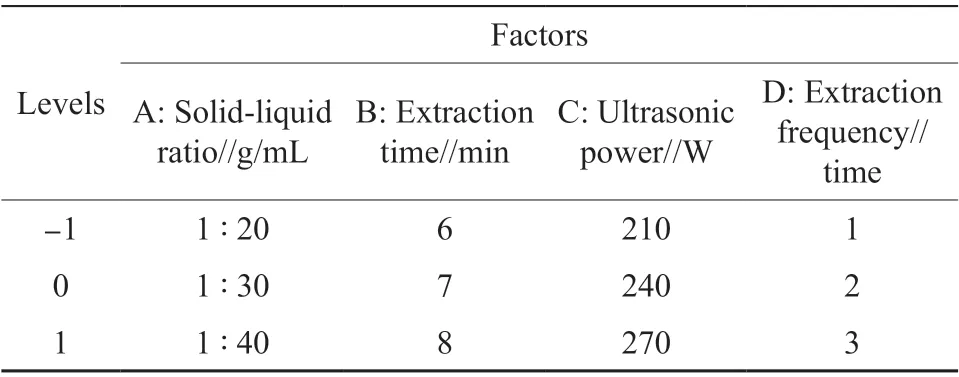
Table 2 Factors and levels design of orthogonal experiment
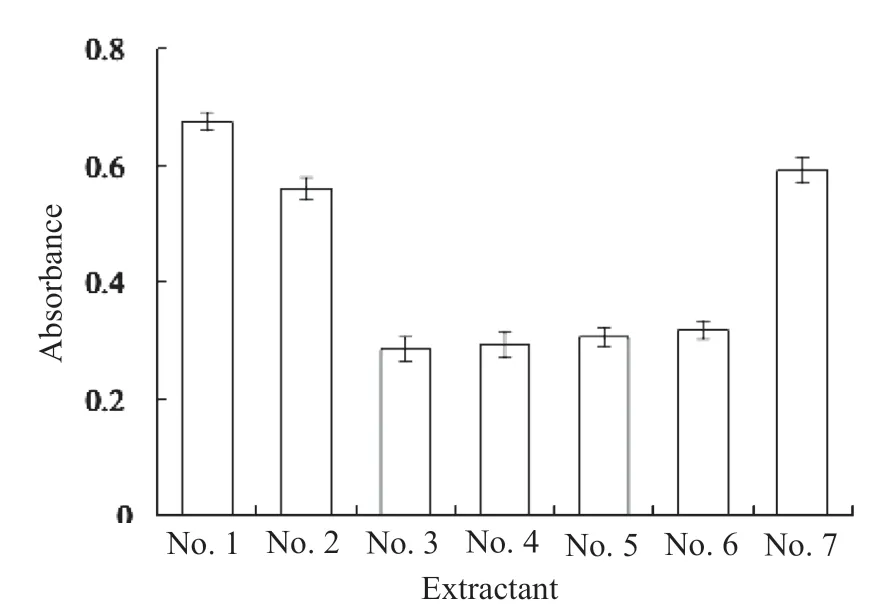
Fig.1 Effect of extractant on the extraction rate of total carotenoid
3.2. Effect of ultrasonic power on the extraction rate of total carotenoid
As shown in Fig.2, the extraction rate of total carotenoid from citrus leaves was the highest when ultrasonic power reached 240 W. This was because the cavitation effect caused by too low ultrasonic power was poor, which could not completely extract total carotenoid from citrus leaves. Due to the intense cavitation effect caused by too high ultrasonic power , the carotenoid molecular structure in citrus leaves was easily changed, resulting in a decrease in extraction rate. Comprehensive consideration, ultrasonic power of 240 W was selected for the test.
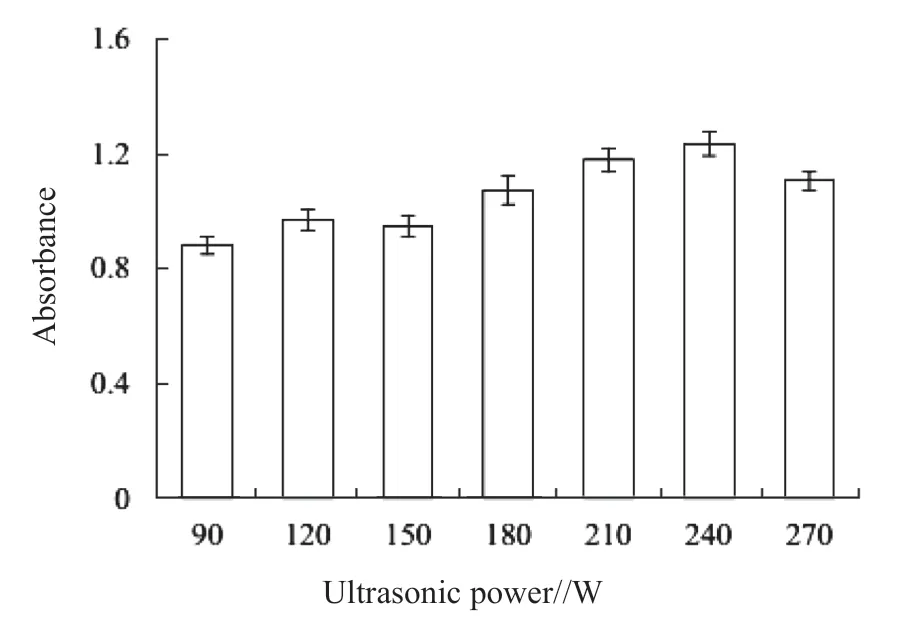
Fig.2 Effect of ultrasonic power on the extraction rate of total carotenoid
3.3. Effect of extraction time on the extraction rate of total carotenoid
As shown in Fig.3, the extraction rate of total carotenoid from citrus leaves was the highest when extraction time was 7 min. This was because too short extraction time resulted in not enough time for carotenoid to be extracted; while too long extraction time made part of the extractant volatile, solid-liquid ratio decreased, resulting in low extraction rate. Comprehensive consideration, extraction time of 7 min was selected for the test.

Fig.3 Effect of extraction time on the extraction rate of total carotenoid
3.4. Effect of extraction temperature on the extraction rate of total carotenoid
As shown in Fig.4, the extraction rate of total carotenoid from citrus leaves was the highest when extraction temperature was 30℃. This was because too low temperature made extraction slow; while too high temperature could not only destroy the molecular structure of carotenoid but also make extractant volatile, resulting in poor extraction effect. Comprehensive consideration, extraction temperature of 30℃ was selected for the test.
Temperature had little effect on the extraction rate and ultrasonic process could easily lead to the temperature fluctuation of ±3℃. Therefore, extraction temperature of 30±3℃ was selected to extract.
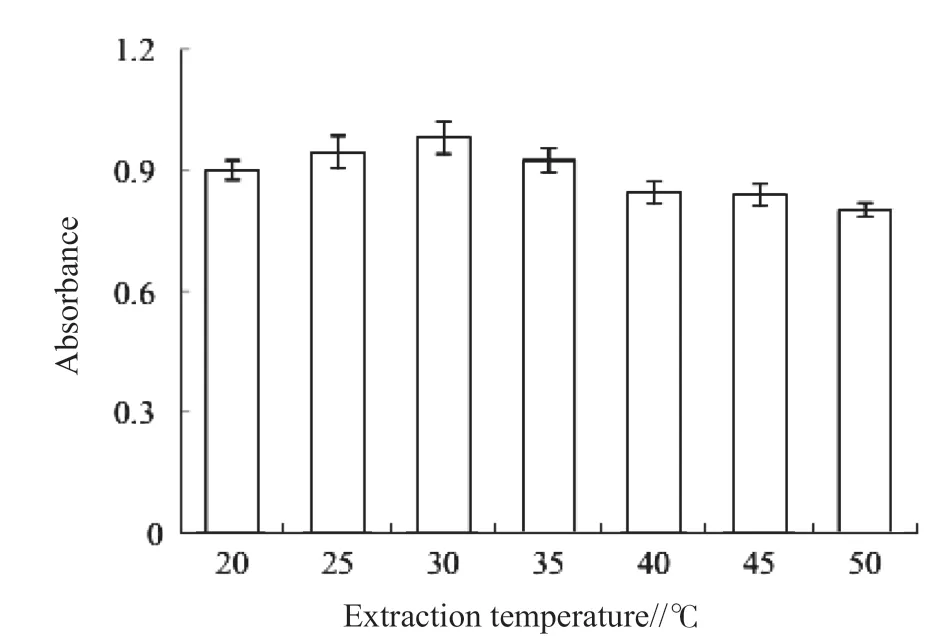
Fig.4 Effect of extraction temperature on the extraction rate of total carotenoid
3.5. Effect of extraction frequency on the extraction rate of total carotenoid
As shown in Fig.5, the extraction rate of total carotenoid from citrus leaves was the highest when extraction frequency was 4 times. This was because completely extracting total carotenoid from citrus leaves would not be possible with too low extraction frequency; while too high extraction frequency had little effect on extraction rate. It can be seen from Fig.5, there was little difference in extraction frequency between 3 times and 4 times. Comprehensive consideration, extraction frequency of 3 times was selected for the test.

Fig.5 Effect of extraction frequency on the extraction rate of total carotenoid
3.6. Orthogonal experiment
Based on single factor experiment, 4 factors including solid-liquid ratio, extraction time, ultrasonic power, extraction frequency and 3 levels orthogonal experiment was conducted at the ultrasonic frequency of 40 kHz with ethyl alcohol ∶acetone = 1 ∶1 as extractant.The results were shown in Table 3.
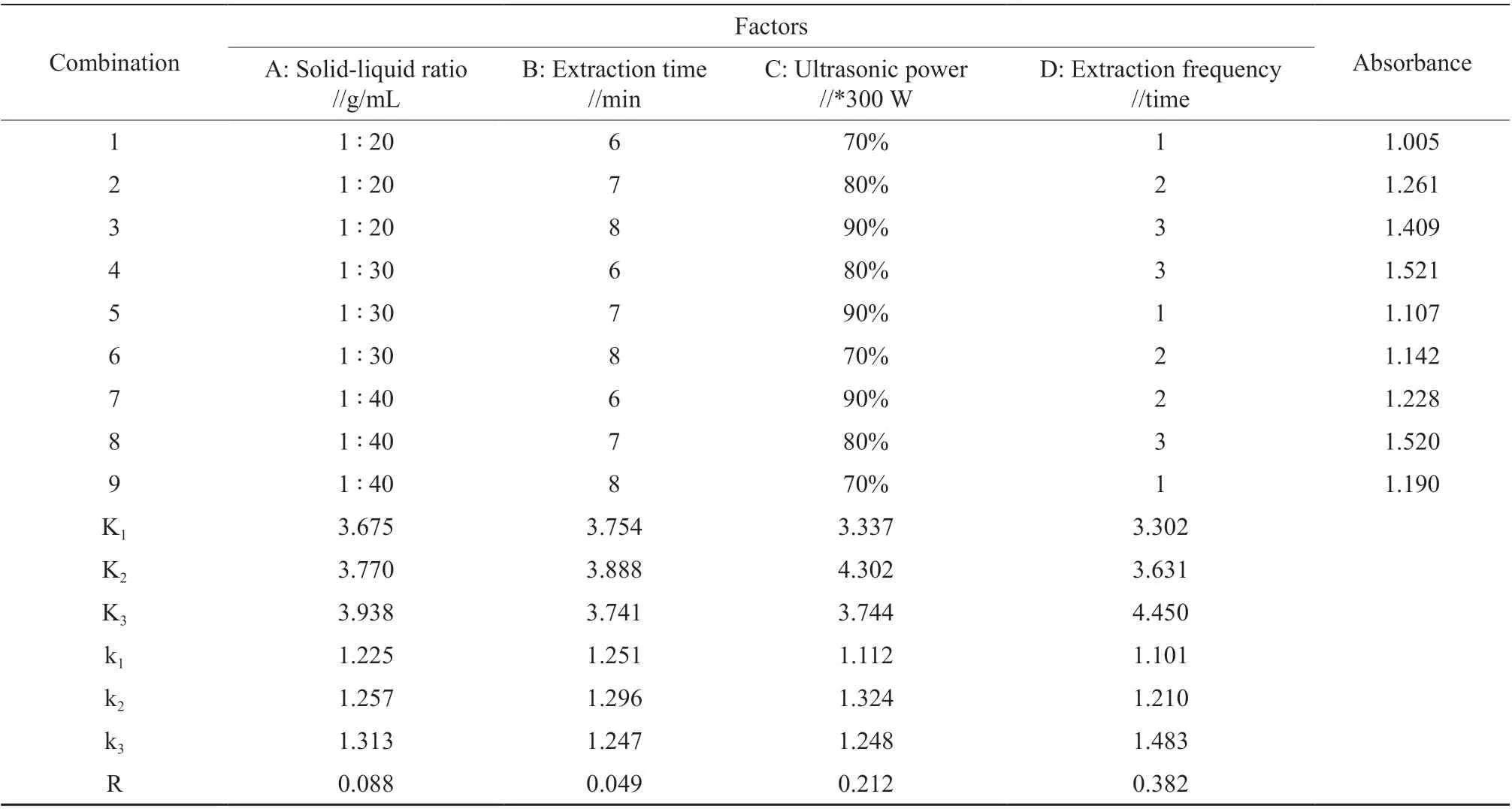
Table 3 Orthogonal experiment results
As shown in Table 3, when ultrasonic frequency was 40 kHz and extractant ratio was ethyl alcohol ∶ acetone = 1∶1, the effects of other factors on extraction rate was in the order: D (Extraction frequency)>C (Ultrasonic power)>A (Solid-liquid ratio)>B (Extraction time). When solid-liquid ratio was 1 ∶30 (g/mL), extraction time was 7 min, ultrasonic power was 240 W and extraction frequency was 3 times, the extraction rate of carotenoid from citrus was the highest.
In order to further explore the effects of A、B、C and D 4 factors on extraction rate of carotenoid from citrus, variance analysis was used to analyze orthogonal experiment data and identify the dominant source of variation in these factors.
In conclusion, the optimal extraction conditionwas: solid-liquid ratio 1 ∶30 (g/mL), extraction time 7 min, ultrasonic power 240 W, extraction frequency 3 times. The extraction rate of carotenoids was 85.98%.
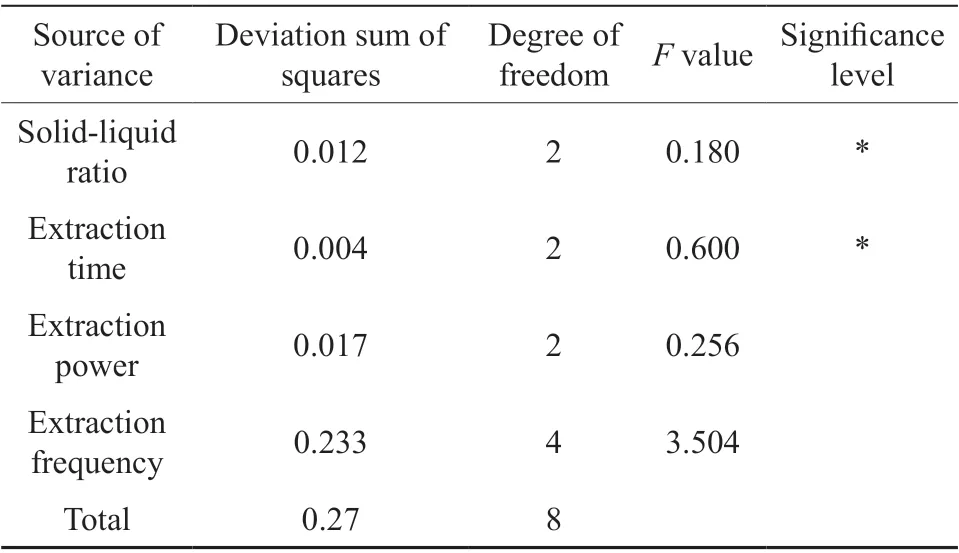
Table 4 Variance analysis results
4. Conclusion and Discussion
Carotenoid from citrus leaves was extracted by ultrasonic assisted extraction and the effects of solid-liquid ratio, extraction power, extraction time and extraction frequency on the extraction rate of carotenoid from citrus leaves were investigated by single factor experiment and orthogonal experimental to obtain the optimal extraction process: the ratio of ethanol and acetone 1 ∶1 (v/v, containing 0.1% BHT), solid-liquid ratio 1 ∶30 (g/mL), extraction time 7 min, ultrasonic power 240 W, extraction frequency 3 times. Under this condition, the extraction rate of carotenoid was 85.98%, higher than that by microwave assisted extraction[10-11].
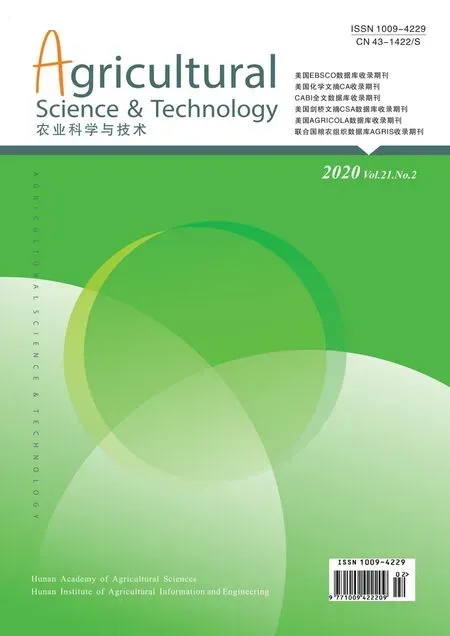 Agricultural Science & Technology2020年2期
Agricultural Science & Technology2020年2期
- Agricultural Science & Technology的其它文章
- Effects of γ Irradiation on Microorganisms in Edible Fungi Matrix
- Optimization of Steam Explosion Process Condition for Extracting Polysaccharides from Pseudostellaria heterophylla by Response Surface Methodology
- Investigation of Salt Stress Response Mechanisms Using Mirna Sequencing of Salt Tolerant and Salt Sensitive Jute Genotypes
- Analysis of Rhizosphere Microbial Community Structure in Different Pathogenesis Stages of Watermelon Fusarium Wilt
- A Study on Planting Adaptability of Various Soybean Varieties in Hengyang
- Analysis on Some Agronomic Characters and Pedigree in Hezihao Series Peanut Varieties
